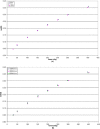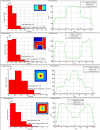Dosimetric characterization and use of GAFCHROMIC EBT3 film for IMRT dose verification
- PMID: 23470940
- PMCID: PMC5714357
- DOI: 10.1120/jacmp.v14i2.4111
Dosimetric characterization and use of GAFCHROMIC EBT3 film for IMRT dose verification
Abstract
Radiochromic film has become an important tool to verify dose distributions in highly conformal radiation therapy such as IMRT. Recently, a new generation of these films, EBT3, has become available. EBT3 has the same composition and thickness of the sensitive layer of the previous EBT2 films, but its symmetric layer configuration allows the user to eliminate side orientation dependence, which is reported for EBT2 films. The most important EBT3 characteristics have been investigated, such as response at high-dose levels, sensitivity to scanner orientation and postirradiation coloration, energy and dose rate dependence, and orientation dependence with respect to film side. Additionally, different IMRT fields were measured with both EBT3 and EBT2 films and evaluated using gamma index analysis. The results obtained show that most of the characteristics of EBT3 film are similar to the EBT2 film, but the orientation dependence with respect to film side is completely eliminated in EBT3 films. The study confirms that EBT3 film can be used for clinical practice in the same way as the previous EBT2 film.
Figures









References
-
- Hartmann B, Martisikova M, Jäkel O. Homogeneity of Gafchromic EBT2 film. Med Phys. 2010;37(4):1753–56. - PubMed
-
- Zeidan OA, Stephenson SA, Meeks SL, et al. Characterization and use of EBT radiochromic film for IMRT dose verification. Med Phys. 2006;33(11):4064–72. - PubMed
-
- Saur S and Frengen J. GafChromic EBT film dosimetry with flatbed CCD scanner: a novel background correction method and full dose uncertainty analysis. Med Phys. 2008;35(7):3094–101. - PubMed
-
- Fuss M, Sturtewagen E, De Wagter C, Georg D. Dosimetric characterization of GafChromic EBT film and its implication on film dosimetry quality assurance. Phys Med Biol. 2007;52(14):4211–25. - PubMed
-
- Matisikova M, Ackermann B, Jakel O. Analysis of uncertainties in Gafchromic EBT film dosimetry of photon beams. Phys Med Biol. 2008;53(24):7013–27. - PubMed
Publication types
MeSH terms
LinkOut - more resources
Full Text Sources
Other Literature Sources

